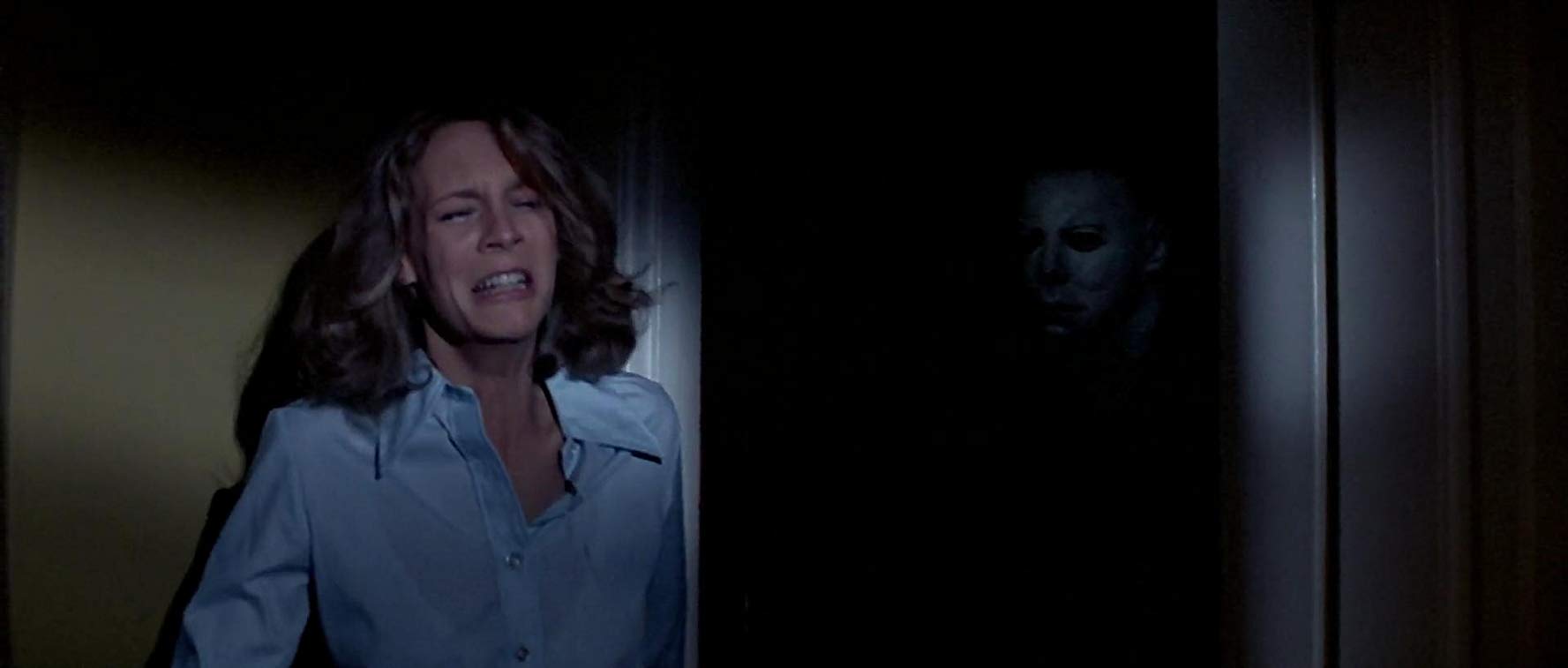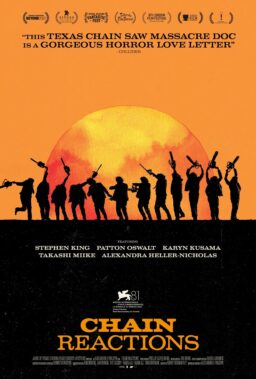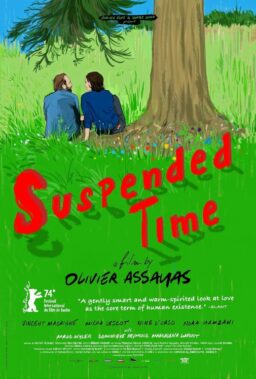I watched John Carpenter’s “Halloween” for the first time in 2003, and I still remember my body tightening during one particular moment. We see a figure walking slowly toward our heroine step by step; our heroine is going to get killed if she cannot escape in time through a door which is unfortunately locked at that very moment. There is still a chance for her, but her time is running out, and she watches in horror as that murderous entity approaching closer and closer to …
I felt the same sensation when I revisited the movie in 2009 and 2013, and the same thing happened to me when I watched it again last night. Sure, it is less shocking now, mainly due to its countless imitators during last 40 years, but the movie still exemplifies the value of mood and suspense, and it remains a superlative horror masterwork that touches upon our basic fear of unknown menace.
Its premise is so simple that it’s more or less a description of the whole plot. The opening sequence, which has a handheld camera functioning as the view of a deranged murderer, jolts us with a terrible act of killing, and then it shocks us further with his identity eventually revealed in the end. After 15 years, the murderer in question escapes from a mental institution at the very moment when his watchful psychiatrist, Dr. Sam Loomis (Donald Pleasence), arrives at the facility for another routine evaluation ordered by court, and Dr. Loomis is quite certain that his homicidal patient is going to return to his hometown: Haddonfield, Illinois.
Now this is a familiar setup for your typical mad killer movie, but “Halloween” distinguishes itself as carefully accumulating a sense of fear and dread in its mundane background surrounding Laurie Strode (Jamie Lee Curtis) and her high school friends. Everything looks fine in Haddonfield on Halloween day, and Laurie is expecting to spend a plain Halloween night with some babysitting, but she gradually senses that something is not quite right around her. At one point, she notices someone watching from the distance, but then the figure in question disappears in the next second, and she cannot help but feel nervous about that. Constantly signifying that something bad is about to happen sooner or later, the movie deftly dials up and down its suspense level as doling out a number of creepy moments like that, and we become more aware of that mysterious figure who is apparently stalking on Laurie.

While that ominous figure, who has been one of the most popular horror genre characters since the movie was released, is merely named “The Shape” in the end credits, the movie gives a little more information on him through Dr. Loomis, who comes to find that his intuition was correct not long after he arrived in Haddonfield. According to Dr. Loomis, his patient is simply an unstoppable evil force of nature as relentless as, say, the shark in “Jaws” (1975), and Donald Pleasence, who has been always associated with his performance in this film and its subsequent unnecessary sequels, is especially good during the scene where his character calmly talks about his patient’s diabolical nature. Even when he savagely stabbed his first victim for no apparent reason, his patient already showed the alarming signs of a merciless psychopathic killer who knows neither compassion nor morality. There is a chilling moment later in the movie when he seems to stare at his latest victim with detached curiosity right after killing that victim.
In its second half, the movie continues to build suspense and dread while not hurrying itself, and director/co-writer John Carpenter masterfully manipulates us through effective thriller devices including several good false alarms, which are placed well around the narrative to maintain tension or relax us a bit for a while. In addition, the movie is not entirely devoid of warmth and humor; Laurie and her friends come to us as likable young girls rather than cardboard characters to be eliminated, and the interactions between Laurie and the kids to be babysat by her are depicted with natural intimacy.
The movie eventually pulls out all the stops during its last 20 minutes, gripping us with several terrifying moments during this climactic part. Despite being less bloody and less violent compared to many other slasher films, its scary moments are still quite effective thanks to Carpenter’s taut direction. Their palpable terror is further amplified by Carpenter’s unforgettable score, which has solidified its own iconic status along with the movie. Although his score mainly consists of simple repetitive rhythms performed by piano and synthesizer, the unnerving mood it generates is indelible to say the least, and we always get nervous whenever its main theme is played to suggest the evil lurking at corners.
While Laurie’s perilous situation is a textbook case of “woman in danger,” Carpenter and his co-writer Debra Hill give us a sensible heroine we can care about, and Jamie Lee Curtis, who got a career breakthrough with this film, gives an earnest performance which nicely fits with her ordinary character. Like anyone would under her dangerous situation, Laurie is quite terrified as her world is turned upside down by the sudden invasion of a mad killer, but this smart young girl tries her best to deal with it, and one of the surprises in the film is how she turns out to be more resourceful than expected as she rises to the occasion in front of the unfathomable evil. When she sees a possible chance for her survival in the nick of the time, she quickly grabs it and then uses it to full extent, and she is certainly a lot more engaging than those boring and colorless heroines in many mediocre slasher movies out there. After subsequently appearing in other horror films including “Halloween II” (1981), Curtis moved onto better things including “A Fish Called Wanda” (1988), but, like Pleasence, she has frequently been associated with “Halloween,” and she does not mind that at all, as shown from her game appearance in “Halloween H20: 20 Years Later” (1998) and the recent 2018 sequel.

“Halloween” was Carpenter’s third film, which came after “Dark Star” (1974) and “Assault on Precinct 13” (1976). Since “Halloween,” he has never attained the same level of commercial success during the rest of his career, but he has instead established himself as a distinctive filmmaker in Hollywood, and he had lots of fun as going around various genres besides horror. While his chilly sci-fi horror film “The Thing” (1982) has gained a considerable cult status thanks to its sticky claustrophobic fun, his other notable works such as “Big Trouble in Little China” (1986) are entertaining to some degrees as going all the way for naughty B-movie sensibility, and there were also some unexpected movies including “Starman” (1984), an exceptionally gentle sci-fi drama which is distinguished by Jeff Bridges’ compelling performance as a visitor from the outer space.
Nevertheless, “Halloween” still remains as the most influential work in Carpenter’s idiosyncratic filmmaking career. After its enormous box office success (as an independent film, it cost only $320,000, and it grossed over $65 million during its initial theatrical release), the movie initiated the boom of slasher films during the following decade. We got not only its several sequels but also many other slasher films including, yes, “Friday the 13th” (1980), though none of these films succeeded in reaching to the sheer terror and intensity of “Halloween” and many of them were eventually thrown away into obscurity. Fortunately, there have also been a bunch of good horror movies which did learn a lot from what was achieved in “Halloween,” and one of the best recent examples is “It Follows” (2014), which does not hide the considerable influence from “Halloween” at all from the beginning while also generating its own creepy mood and impression.
At present, “Halloween” does not scare me as much as it did the first time, but its disturbing power remains intact nonetheless, and my admiration of its dexterous handling of shock and suspense has grown with repeat viewings. A good shock always requires building up a considerable amount of suspense before it’s eventually served on the screen. Carpenter’s film is packed with many great moments that will remind you of that again and again for many scary nights to come.











